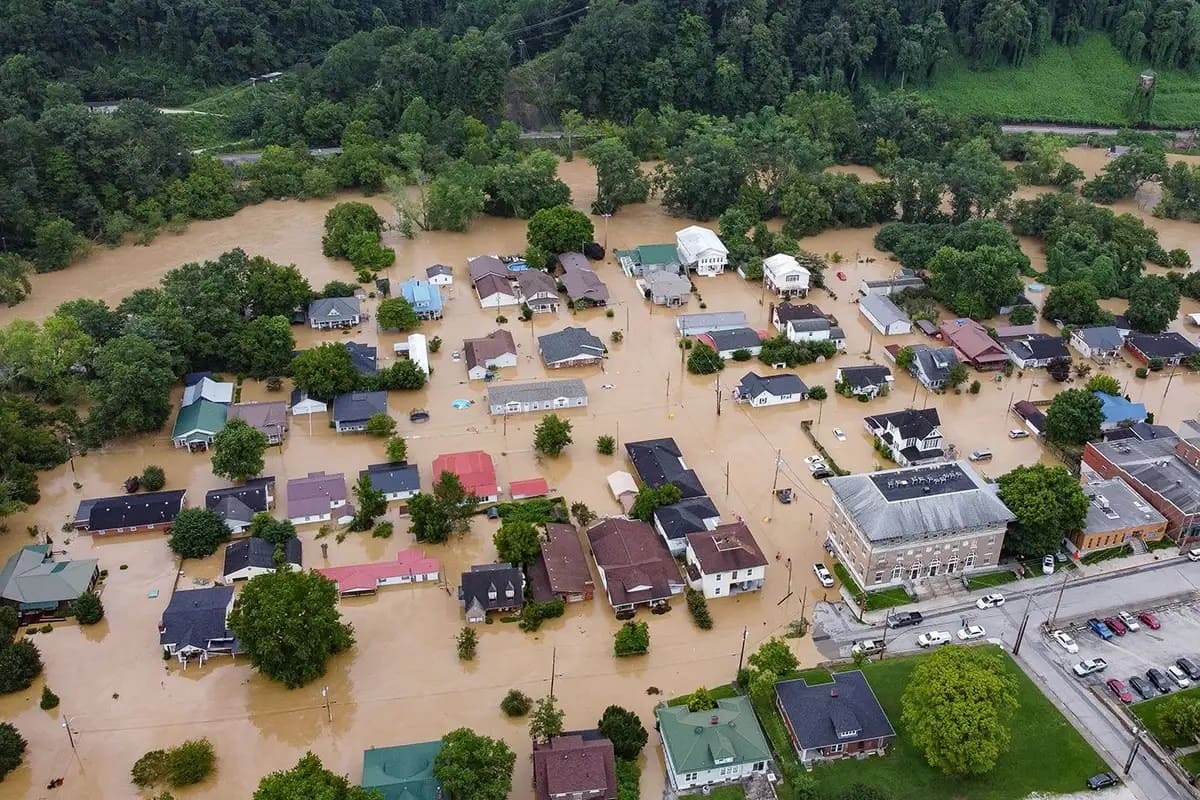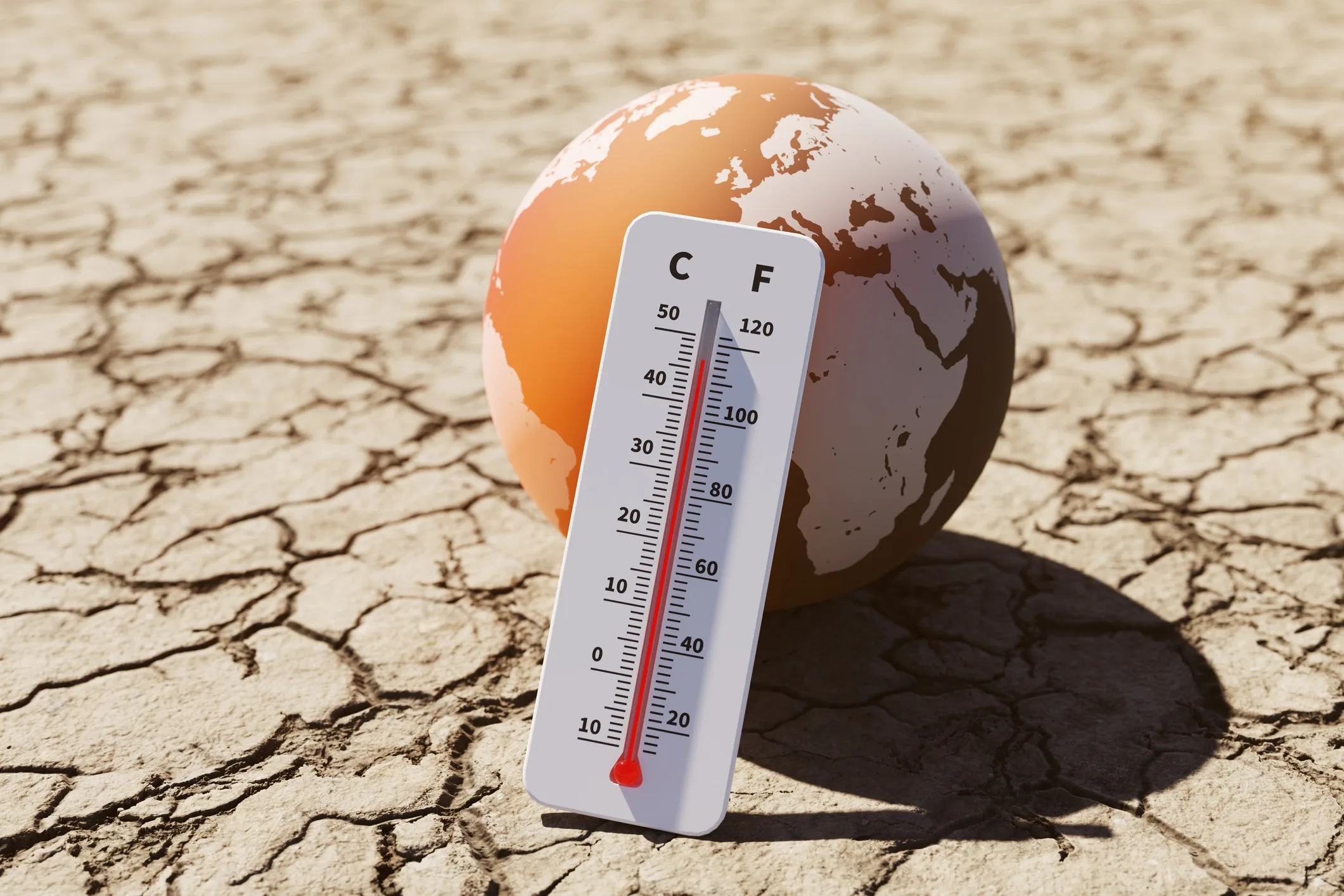Home>Weather and Climate>The Impact Of Energy Imbalance On Earth’s Temperature Dynamics


Weather and Climate
The Impact Of Energy Imbalance On Earth’s Temperature Dynamics
Published: March 6, 2024
Explore the intricate relationship between weather and climate as we delve into the impact of energy imbalance on Earth's temperature dynamics. Understand the complex interplay of factors shaping our planet's climate.
(Many of the links in this article redirect to a specific reviewed product. Your purchase of these products through affiliate links helps to generate commission for Temperatures.com, at no extra cost. Learn more)
Table of Contents
Introduction
The delicate balance of Earth's climate is governed by a complex interplay of various factors, including solar radiation, greenhouse gases, and the planet's energy budget. This intricate equilibrium is crucial for maintaining the stability of our climate and ensuring the habitability of our planet. However, in recent years, the concept of energy imbalance has emerged as a significant concern within the realm of climate science.
Energy imbalance refers to the disparity between the amount of solar energy absorbed by the Earth and the energy that is radiated back into space. When this equilibrium is disrupted, it can have profound implications for the planet's temperature dynamics, weather patterns, and overall climate stability. Understanding the causes and consequences of energy imbalance is essential for comprehending the intricate mechanisms that govern our planet's climate system.
In this article, we will delve into the intricate dynamics of energy imbalance and its far-reaching impact on Earth's temperature. By exploring the factors contributing to energy imbalance, the consequences it poses for our planet, and the potential solutions to mitigate its effects, we aim to shed light on this critical aspect of climate science. As we unravel the complexities of energy imbalance, we will gain a deeper appreciation for the delicate interplay of forces that shape our planet's climate and the urgent need for sustainable practices to safeguard the future of our environment.
Read more: The Impact Of Sunspots On Earth’s Climate
Understanding Energy Imbalance
Energy imbalance is a fundamental concept in climate science that pertains to the disparity between the incoming solar radiation absorbed by the Earth and the outgoing thermal radiation emitted back into space. This imbalance, often referred to as the Earth's energy budget, plays a pivotal role in shaping the planet's temperature dynamics and overall climate stability.
At the heart of this phenomenon lies the intricate interplay between the energy received from the sun and the energy radiated by the Earth. When the incoming solar radiation exceeds the outgoing thermal radiation, an energy surplus occurs, leading to a net gain of heat within the Earth's system. Conversely, if the outgoing thermal radiation surpasses the incoming solar radiation, an energy deficit ensues, resulting in a net loss of heat from the planet.
The primary driver of energy imbalance is the escalating concentration of greenhouse gases in the atmosphere, which impedes the outward radiation of thermal energy, thereby trapping heat within the Earth's system. This phenomenon, known as the greenhouse effect, intensifies the energy surplus, leading to a gradual rise in global temperatures and contributing to the overarching issue of climate change.
Moreover, human activities, such as the combustion of fossil fuels and deforestation, have significantly augmented the concentration of greenhouse gases, exacerbating the energy imbalance and amplifying its impact on the Earth's climate. The resultant perturbations in the planet's energy budget have far-reaching implications, influencing weather patterns, ocean currents, and the frequency and intensity of extreme weather events.
Understanding energy imbalance is crucial for comprehending the intricate mechanisms that underpin our planet's climate system. By unraveling the complexities of this phenomenon, scientists can gain valuable insights into the factors driving climate change and devise effective strategies to mitigate its adverse effects. As we delve deeper into the dynamics of energy imbalance, we gain a profound appreciation for the delicate equilibrium that governs our planet's climate and the urgent need for sustainable practices to restore this balance and safeguard the future of our environment.
Earth's Temperature Dynamics
The temperature dynamics of Earth are intricately linked to the planet's energy balance and play a pivotal role in shaping its climate. The distribution of heat across the globe is influenced by a myriad of factors, including solar radiation, atmospheric composition, ocean currents, and land surface characteristics. These elements collectively contribute to the complex interplay of forces that govern the planet's temperature dynamics.
One of the defining features of Earth's temperature dynamics is the stark contrast between the equatorial regions and the polar zones. The equatorial regions receive a higher influx of solar radiation, leading to elevated temperatures and the formation of tropical climates characterized by lush rainforests and vibrant biodiversity. In contrast, the polar zones experience prolonged periods of reduced solar radiation, resulting in frigid temperatures and the formation of polar ice caps and tundra landscapes.
Furthermore, the Earth's temperature dynamics are intricately linked to the circulation of the atmosphere and oceans. Atmospheric circulation, driven by the differential heating of the Earth's surface, gives rise to prevailing wind patterns and the formation of weather systems. Similarly, oceanic currents play a crucial role in redistributing heat across the globe, influencing regional climates and the productivity of marine ecosystems.
The planet's temperature dynamics also exhibit seasonal variations, with the tilt of the Earth's axis giving rise to the cyclical patterns of summer and winter. This axial tilt leads to the differential heating of the hemispheres, resulting in the alternating seasons experienced across the globe. These seasonal fluctuations in temperature profoundly impact ecosystems, agricultural practices, and human activities, shaping the fabric of life on Earth.
Moreover, the intricate interplay between land and water surfaces significantly influences the temperature dynamics of different regions. Land surfaces tend to heat up and cool down more rapidly than water bodies, leading to the formation of distinct microclimates and contributing to the diversity of terrestrial ecosystems.
In essence, the temperature dynamics of Earth are a testament to the intricate web of interactions that govern the planet's climate. By unraveling the complexities of these dynamics, scientists can gain valuable insights into the mechanisms driving climate variability and devise strategies to mitigate the impacts of climate change. Understanding the nuances of Earth's temperature dynamics is essential for safeguarding the delicate balance of our planet's climate and ensuring a sustainable future for generations to come.
Factors Contributing to Energy Imbalance
The intricate balance of Earth's energy budget is influenced by a myriad of factors that collectively contribute to the phenomenon of energy imbalance. Understanding these underlying factors is crucial for comprehending the complexities of climate change and devising effective strategies to mitigate its impact. Several key elements contribute to the disruption of the Earth's energy equilibrium, amplifying the challenges posed by energy imbalance:
-
Greenhouse Gas Emissions: The escalating concentration of greenhouse gases, including carbon dioxide (CO2), methane (CH4), and nitrous oxide (N2O), is a primary driver of energy imbalance. Human activities, such as the burning of fossil fuels, industrial processes, and deforestation, have significantly augmented the levels of these gases in the atmosphere. This intensifies the greenhouse effect, leading to the trapping of thermal radiation within the Earth's system and the subsequent elevation of global temperatures.
-
Albedo Effect: Changes in the Earth's surface characteristics, such as the melting of polar ice caps and the expansion of urban areas, can alter the planet's albedo, or its ability to reflect solar radiation. Reduced albedo, resulting from the darkening of surfaces, leads to increased absorption of solar energy, further exacerbating energy imbalance and contributing to the warming of the planet.
-
Solar Variability: Fluctuations in solar activity, including variations in solar radiation and sunspot cycles, can influence the amount of energy reaching the Earth. While natural solar variability has historically played a role in shaping the planet's climate, the impact of human-induced factors, such as greenhouse gas emissions, has become increasingly dominant in driving energy imbalance.
-
Land Use Changes: Human activities, such as urbanization, agricultural expansion, and deforestation, have altered the land surface, leading to changes in the absorption and reflection of solar radiation. These land use changes can contribute to localized energy imbalances, impacting regional climates and ecosystems.
-
Aerosols and Particulate Matter: The presence of aerosols and particulate matter in the atmosphere can influence the scattering and absorption of solar radiation, thereby affecting the planet's energy budget. While certain aerosols can contribute to cooling effects by reflecting sunlight, others, such as black carbon, can absorb solar radiation and contribute to warming.
-
Feedback Mechanisms: The complex interactions between various components of the Earth's climate system give rise to feedback mechanisms that can amplify or dampen the effects of energy imbalance. For instance, the melting of polar ice caps reduces the albedo of the Earth's surface, leading to increased absorption of solar radiation and further ice melt, creating a self-reinforcing feedback loop.
By comprehensively examining these factors contributing to energy imbalance, scientists can gain valuable insights into the intricate mechanisms driving climate change. This deeper understanding is essential for formulating evidence-based policies and implementing sustainable practices to mitigate the adverse effects of energy imbalance on our planet's climate.
Consequences of Energy Imbalance on Earth's Temperature
The ramifications of energy imbalance on Earth's temperature are profound and far-reaching, exerting a pervasive influence on the planet's climate system and ecosystems. As the disparity between incoming solar radiation and outgoing thermal radiation intensifies, a cascade of consequential effects unfolds, reshaping weather patterns, exacerbating extreme events, and accelerating the pace of climate change.
One of the most palpable consequences of energy imbalance is the escalating trend of global warming. The surplus of heat trapped within the Earth's system, primarily attributed to the intensification of the greenhouse effect, has led to a discernible rise in average global temperatures. This warming trend manifests in various forms, including the melting of polar ice caps, the acidification of oceans, and the disruption of ecosystems, posing a formidable threat to biodiversity and ecological balance.
Moreover, energy imbalance exerts a discernible impact on weather patterns, contributing to the intensification of extreme events such as heatwaves, droughts, and intense precipitation. The amplification of these events can have devastating implications for human societies, agricultural productivity, and the resilience of natural ecosystems. Furthermore, the altered distribution of heat across the globe can disrupt established climate patterns, leading to shifts in precipitation regimes, the intensification of storms, and the exacerbation of natural disasters.
The consequences of energy imbalance extend beyond atmospheric and surface phenomena, permeating into the depths of the oceans. The imbalance in energy distribution drives changes in oceanic temperatures and currents, influencing marine ecosystems and the frequency of oceanic heatwaves. These alterations in ocean dynamics can have profound implications for marine life, including the disruption of migration patterns, the bleaching of coral reefs, and the depletion of fisheries.
Additionally, the repercussions of energy imbalance reverberate across the cryosphere, contributing to the accelerated retreat of glaciers, the destabilization of ice shelves, and the disintegration of polar ice sheets. These changes not only contribute to rising sea levels but also impact regional climates, freshwater availability, and the vulnerability of coastal communities to inundation and erosion.
The compounding effects of energy imbalance underscore the urgency of addressing climate change and implementing sustainable practices to restore the delicate equilibrium of the Earth's energy budget. By comprehensively understanding the consequences of energy imbalance, we can galvanize collective action to mitigate its impacts, foster resilience in the face of climate change, and safeguard the future of our planet for generations to come.
Mitigating Energy Imbalance through Sustainable Practices
Addressing the pervasive challenge of energy imbalance necessitates a concerted effort to implement sustainable practices that restore the equilibrium of the Earth's energy budget. By embracing innovative approaches and fostering collective action, humanity can mitigate the adverse effects of energy imbalance and chart a path towards a more resilient and sustainable future.
One pivotal strategy for mitigating energy imbalance involves transitioning towards renewable energy sources, such as solar, wind, and hydroelectric power. By harnessing the abundant energy provided by these renewable sources, societies can reduce their reliance on fossil fuels, thereby curbing greenhouse gas emissions and mitigating the intensification of the greenhouse effect. Embracing renewable energy not only contributes to the restoration of the Earth's energy balance but also fosters energy security, stimulates economic growth, and mitigates the impact of climate change.
Furthermore, sustainable land management practices, including afforestation, reforestation, and sustainable agricultural techniques, play a crucial role in mitigating energy imbalance. Forest ecosystems serve as carbon sinks, sequestering atmospheric carbon dioxide and mitigating the concentration of greenhouse gases. By preserving and restoring forested areas, as well as adopting sustainable agricultural practices that minimize deforestation and soil degradation, societies can contribute to the restoration of the Earth's energy equilibrium while promoting biodiversity and ecosystem resilience.
Additionally, enhancing energy efficiency across various sectors, including transportation, industry, and residential buildings, is instrumental in mitigating energy imbalance. By optimizing energy usage and reducing wastage, societies can minimize their carbon footprint and alleviate the strain on the planet's energy budget. Embracing energy-efficient technologies, implementing stringent building codes, and promoting sustainable transportation solutions are pivotal steps towards restoring the delicate balance of Earth's energy dynamics.
Moreover, fostering international cooperation and enacting evidence-based policies are essential for mitigating energy imbalance on a global scale. By forging partnerships and agreements that prioritize sustainable development, emissions reduction, and climate resilience, nations can collectively work towards restoring the equilibrium of the Earth's energy budget. This collaborative approach is crucial for addressing the transboundary nature of energy imbalance and its far-reaching implications for the planet's climate system.
In essence, mitigating energy imbalance through sustainable practices requires a multifaceted approach that encompasses renewable energy adoption, sustainable land management, energy efficiency measures, and international collaboration. By embracing these strategies and prioritizing the restoration of the Earth's energy equilibrium, humanity can pave the way for a more sustainable and harmonious coexistence with the planet, ensuring a resilient future for generations to come.
Conclusion
In conclusion, the concept of energy imbalance stands as a pivotal determinant of Earth's climate dynamics, exerting a profound influence on the planet's temperature, weather patterns, and overall climate stability. The intricate interplay of factors contributing to energy imbalance, including greenhouse gas emissions, changes in land use, solar variability, and feedback mechanisms, underscores the complexity of this phenomenon and its far-reaching implications for the planet.
The consequences of energy imbalance, manifested in the form of global warming, altered weather patterns, oceanic changes, and cryospheric transformations, underscore the urgency of addressing climate change and implementing sustainable practices. The escalating trend of extreme events, the disruption of ecosystems, and the vulnerability of coastal communities highlight the imperative for collective action to mitigate the adverse effects of energy imbalance.
However, amidst these challenges, there exists a beacon of hope in the form of sustainable practices that can mitigate energy imbalance and restore the delicate equilibrium of the Earth's energy budget. Embracing renewable energy sources, implementing sustainable land management practices, enhancing energy efficiency, and fostering international cooperation stand as pillars of resilience in the face of climate change.
By prioritizing these strategies and galvanizing collective action, humanity can chart a path towards a more sustainable and harmonious coexistence with the planet. The restoration of the Earth's energy equilibrium through evidence-based policies, innovative technologies, and a shared commitment to environmental stewardship holds the key to safeguarding the future of our planet for generations to come.
As we navigate the complexities of energy imbalance and its impact on Earth's climate, it is imperative to recognize the interconnectedness of all life on our planet and the profound responsibility we bear in preserving its delicate balance. By embracing sustainable practices, fostering resilience, and championing the restoration of the Earth's energy equilibrium, we can forge a path towards a more sustainable and resilient future, ensuring the well-being of both current and future generations.














